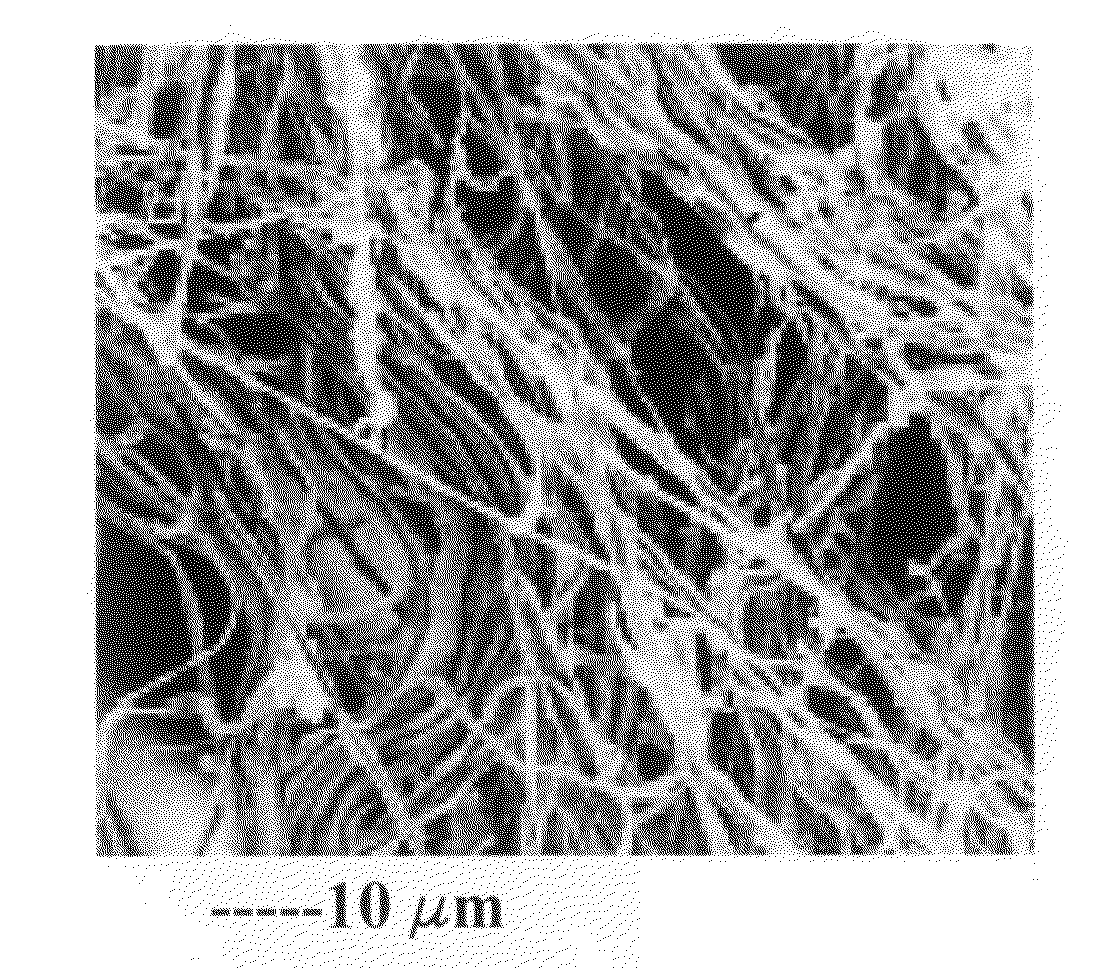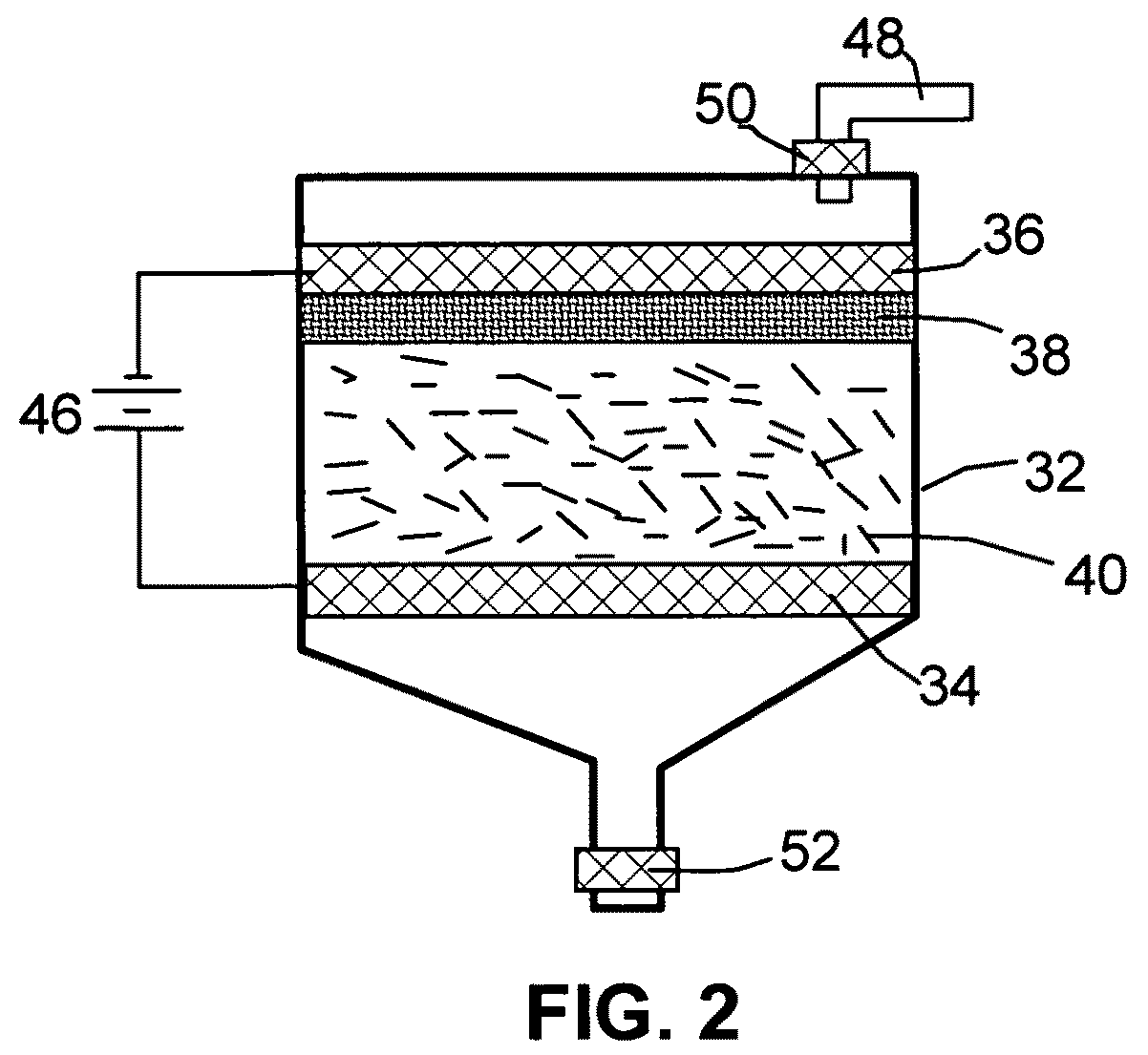Nano-scaled graphene platelets with a high length-to-width aspect ratio
a nano-scaled graphene and aspect ratio technology, applied in the field of new nano-scaled graphene platelets, can solve the problems of not being taught the length-to-thickness ratio or the length-to-width ratio of ngp, and achieve the effect of high length-to-width aspect ratio
- Summary
- Abstract
- Description
- Claims
- Application Information
AI Technical Summary
Benefits of technology
Problems solved by technology
Method used
Image
Examples
example 1
NGPs from PAN-Based Graphite Fibers
[0062]Continuous graphite fiber yarns (Magnamite from Hercules) were cut into segments of 5 mm long and then ball-milled for 24 hours. Approximately 20 grams of these milled fibers were immersed in a mixture of 2 L of formic acid and 0.1 L of hydrogen peroxide at 45° C. for 24 hours. Following the chemical oxidation intercalation treatment, the resulting intercalated fibers were washed with water and dried. The resulting product is a formic acid-intercalated graphite fiber material.
[0063]Subsequently, approximately ½ of the intercalated fiber sample was transferred to a furnace pre-set at a temperature of 600° C. for 30 seconds. The compound was found to induce extremely rapid and high expansions of graphite crystallites. Further separation of exfoliated flakes using a Cowles shearing device led to the formation of NGPs. The thickness of individual platelets was found to range from two graphene sheets to approximately 25 graphene sheets (average of...
example 2
NGPs from Sulfuric / Nitric Acid-Intercalated Pitch-Based Carbon Fibers and Nanocomposites Containing Such NGPs
[0069]Fifty grams each of a series of carbon and graphite fibers from Amoco (P-25, P-30X, P-55S, P-75S, P-100S, and P-120S) were intercalated with a mixture of sulfuric acid, nitric acid, and potassium permanganate at a weight ratio of 4:1:0.05 (graphite-to-intercalate ratio of 1:3) for four hours. Upon completion of the intercalation reaction, the mixture was poured into deionized water and filtered. The sample was then washed with 5% HCl solution to remove most of the sulfate ions and residual salt and then repeatedly rinsed with deionized water until the pH of the filtrate was approximately 5. The dried sample was then exfoliated at 1,050° C. for 45 seconds. These samples were separately submitted to a mechanical shearing treatment in a Cowles (a rotating-blade dissolver / disperser) for 10 minutes. The resulting NGPs were examined using SEM and TEM and their length, width, ...
example 3
NGPs from Electrochemical Intercalation and Exfoliation of Carbon Fibers
[0072]One gram of P-25 fibers, ground to approximately 220 μm in sizes, was used as the anode material and 1 L of nitric acid was used as the electrolyte and intercalate source. The anode supporting element is a platinum plate and the cathode is a graphite plate of approximately 4 cm in diameter and 0.2 cm in thickness. The separator, a glass fiber fabric, was used to separate the cathode plate from the graphite flakes and to compress the graphite flakes down against the anode supporting element to ensure that the carbon fiber segments are in electrical contact with the anode supporting element to serve as the anode. The electrodes, electrolyte, and separator are contained in a Buchner-type funnel to form an electrochemical cell. The anode supporting element, the cathode, and the separator are porous to permit intercalate (electrolyte) to saturate the graphite and to pass through the cell from top to bottom.
[007...
PUM
| Property | Measurement | Unit |
|---|---|---|
| thickness | aaaaa | aaaaa |
| thickness | aaaaa | aaaaa |
| thickness | aaaaa | aaaaa |
Abstract
Description
Claims
Application Information
 Login to View More
Login to View More - R&D
- Intellectual Property
- Life Sciences
- Materials
- Tech Scout
- Unparalleled Data Quality
- Higher Quality Content
- 60% Fewer Hallucinations
Browse by: Latest US Patents, China's latest patents, Technical Efficacy Thesaurus, Application Domain, Technology Topic, Popular Technical Reports.
© 2025 PatSnap. All rights reserved.Legal|Privacy policy|Modern Slavery Act Transparency Statement|Sitemap|About US| Contact US: help@patsnap.com



